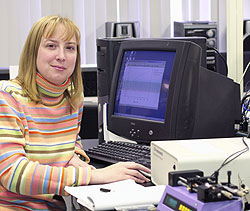Cell phone batteries could be powered by OJ
Cell phone batteries could be powered by OJ
mongabay.com
March 26, 2007
Researchers at Saint Louis University in Missouri have developed a fuel cell battery that can run on virtually any sugar source — from orange juice to tree sap — and may last three to four times longer than conventional lithium ion batteries.
“This study shows that renewable fuels can be directly employed in batteries at room temperature to lead to more energy-efficient battery technology than metal-based approaches,” said Shelley Minteer, an electrochemist at Saint Louis University who described the findings at the 233rd national meeting of the American Chemical Society in Chicago. “It demonstrates that by bridging biology and chemistry, we can build a better battery that’s also cleaner for the environment.”
The batteries work by using enzymes to strip charges from sugar to generate electricity in fuel cells while leaving water as the main byproduct. All materials used to build the sugar battery are biodegradable, explained Minteer.
The batteries could run on a wide range of sugars.

Saint Louis University chemistry professor Shelley Minteer, Ph.D. |
“So far, Minteer has run the batteries on glucose, flat sodas, sweetened drink mixes and tree sap, with promising results,” reported a news release from Saint Louis University. “She also tested carbonated beverages, but carbonation appears to weaken the fuel cell. The best fuel source tested so far is ordinary table sugar (sucrose) dissolved in water.”
According to the release, Minteer envisions using the sugar fuel cell “as a portable cell phone recharger, similar to the quick rechargers already on the market that allow users to instantly charge their cell phones while ‘on the go.’ Ideally, these rechargers would contain special cartridges that are pre-filled with a sugar solution.”
Minteer says the battery could be ready for commercialization in three to five years. She notes that the military has shown interest in the sugar battery for charging portable electronic equipment where access to electricity is limited.
Related article
Bacteria can generate renewable energy from sewage, help fight global warming. Currently, most energy production generates carbon dioxide, a potent greenhouse gas that contributes to global warming and local pollution. At the same time that carbon dioxide concentrations are rising in the atmosphere, fueling higher temperatures, burgeoning population growth of humans and livestock is producing ever-increasing amounts of organic pollution and waste. Now researchers at the Center for Biotechnology at the Biodesign Institute of Arizona State University are working on a way to solve both problems using bacteria to convert organic wastes into a source of electricity.
Bacteria can ensure clean water say researchers. Water is shaping up to be one of the most critical problems facing humanity. With water consumption far outstripping population growth rates due to surging industrial and agricultural demand, the World Bank estimates that 40 percent of the world’s population — more than 2.5 billion people — are enduring some form of water scarcity. Still water experts argue that the problem is not a fundamental lack of water — there is in fact plenty of freshwater to go around — but where it’s located and growing levels of pollution. Even in places where water is not scarce, it is often contaminated or “impaired” with natural containments and fertilizer runoff containing nitrates and perchlorate. While systems exist for dealing with these problems, they typically concentrate compounds and are costly to maintain, especially in poor parts of the world where water is most needed. This may all soon change. Researchers at Arizona State’s Biodesign Institute have devised a way for bacteria to do the dirty work — converting wastewater to clean drinking water using a minimal amount of energy and generating no harmful waste.
This article uses quotes and information from Saint Louis University.